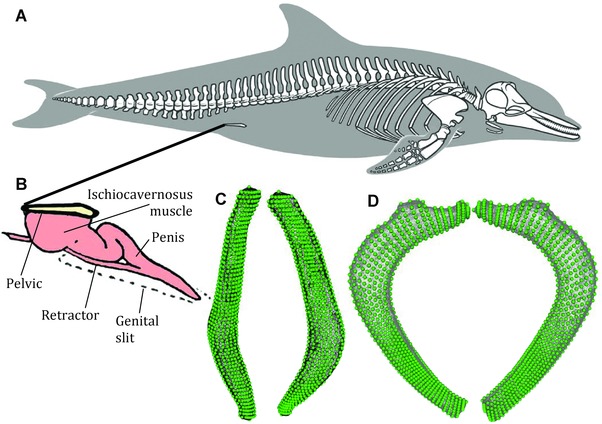
Do Dolphins Have Hip Bones? Yes, dolphins do have pelvic (hip) bones1, although they are not attached to their back limbs. The hip bones are part of the cetacean skeleton, a vestigial structure from the evolutionary development of four-legged land ancestors to water-dwelling creatures.
These bones maintain muscle attachments that help with swimming, but they are not needed for walking.
Dolphin anatomy can be used for learning about the past evolution and aquatic locomotion adaptations of these animals.
Dolphins’ hip bones are an amazing illustration of how some species have adapted to survive in their natural environments.
Scientists and academics may now better understand the biomechanics and adaptive abilities of these amazing marine mammals thanks to this knowledge.
Table of Contents
Mysteries Beneath The Surface
Investigating the evolutionary importance of dolphin structure is fascinating when it comes to knowing about dolphin physiology.
Dolphins’ amazing adaptations to flourish in a marine setting, in contrast to land mammals, highlight the considerable distinctions in their skeletal system.
One notable characteristic that differentiates dolphins from their terrestrial counterparts is that they do not have visible hip bones.
Dolphin locomotion and hydrodynamics are optimized by the skeletal arrangement, not by a pelvis that can carry body weight.
The striking differences in anatomical structure between land and marine mammals provide a significant understanding of the various routes of evolutionary adaptation.
Through an examination of dolphins’ unique adaptations, experts are able to comprehend the complex ecological niches that other species occupy on a deeper level.
Tracing The Evolutionary Tale
Do Dolphins Have Hip Bones? Tracing the Evolutionary Tale
Evolutionary researchers have long been fascinated by the fact that dolphins have hip bones. Studying the evolutionary history of these marine mammals depends heavily on these vestiges, which are the remains of their terrestrial forebears.
Although these bones are not directly responsible for a dolphin’s ability to travel through the water, they are essential to the structure of the reproductive system and other internal organs.
The evolutionary adaptations that allowed these animals to flourish in watery habitats are illuminated by the connection between their hip bones and their terrestrial ancestors.
Gaining knowledge about how hip bones support dolphin anatomy now will help us better understand the complex process of evolution and the amazing changes that have molded life on Earth.
See Also: Do Dolphins Have Backbones? The Hidden Marvel of Dolphins
The Role Of Hip Bones In Movement
Dolphins are renowned for their beautiful and swift swimming techniques, but do they have terrestrial animals’ hip bones?
Dolphins have interesting skeletal adaptations for swimming, particularly with regard to their hip bones. Dolphins have a tiny, vestigial pelvic bone that is separate from their spinal column, unlike land mammals2.
This special modification enables streamlined swimming and effective tail movement. Dolphin propulsion and quickness in the water depend heavily on the relationship between hip bones and tail movement.
Dolphins’ unique adaptations show off their amazing evolutionary history in addition to setting them apart from other aquatic animals. [Do Dolphins Have Hip Bones?]

Genetic Secrets And Skeletal Clues
Dolphins are amazing animals that have changed from being land-dwelling mammals to being graceful, elegant swimmers.
Their hip bones were formerly used to sustain their weight on land, according to fossil records, but throughout time, these bones have shrunk and grown more streamlined.
This theory is further supported by DNA evidence, which reveals genetic traces of their terrestrial past. Dolphins have changed significantly in terms of their bone structure as compared to their prehistoric ancestors.
These skeletal hints and genetic mysteries provide fascinating new perspectives on dolphin evolution and the adaptations that have helped them survive in the water. [Do Dolphins Have Hip Bones?]
Understanding Dolphins’ Terrestrial Heritage
Compared to land-dwelling mammals, dolphins’ hip bones are less noticeable. Their evolutionary history and biological background are reflected in this.
Dolphins’ biology has been significantly shaped by their environment, especially during their move from land to water.
The advantages of eliminating prominent hip bones for evolution include more efficient swimming and less water resistance.
Their sustained success as a species has been facilitated by this adaptation, which indicates their ability to survive in an aquatic setting. [Do Dolphins Have Hip Bones?]
See Also: Do Dolphins Have Toes? The Unexpected Truth About Their Toes
Frequently Asked Questions Of Do Dolphins Have Hip Bones?
Are Hip Bones Essential For Dolphins’ Movement?
Dolphins do indeed have hip bones, however, they are not joined to the spine. Their hind limbs, which have developed into flippers to help with swimming and gliding underwater, are supported by these bones.
Do Dolphins Have Vestigial Hip Bones?
Absolutely, dolphins still possess vestiges of their ancestors’ terrestrial existence, such as their hip bones. After hundreds of thousands of years of development, dolphins have evolved into wholly aquatic life, thus these bones no longer fulfill their original purpose.
How Do Dolphins Use Their Hip Bones?
The muscles that regulate a dolphin’s pelvic appendages are supported and anchored by its hip bones. Although they no longer have hind limbs, dolphins nevertheless need their hip bones for swimming and to assist the growth of their muscles.
Conclusion
Hip bones are present in dolphins; however, they are not closely linked to the spinal column. Their special adaptability makes them more proficient and nimble swimmers.
Dolphins’ amazing adaptations that have helped them to flourish in their watery environment and their evolutionary history can be understood through the study of their anatomy.

Mr. Das, a certified pharmaceutical scientist, holds a Bachelor of Science in Pharmaceutical Sciences and passionately contributes to dolphin conservation as a member of the committee in Bangladesh.


